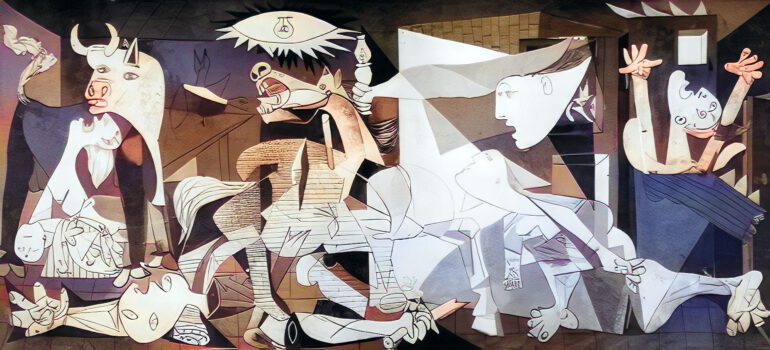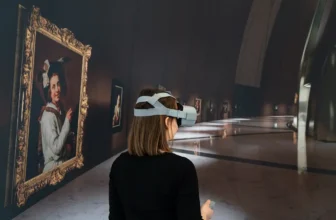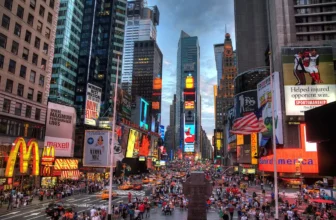Guernica, the iconic painting by Pablo Picasso, stands as one of the most powerful anti-war artworks in history. Painted in 1937, Guernica is a monumental black-and-white canvas that encapsulates the horrors of war, suffering, and human anguish. The work transcends time, culture, and language, speaking universally to the atrocities of violence and the resilience of the human spirit. In this extensive exploration, we will delve into the painting’s origin, symbolism, style, interpretation, and current location, seeking to uncover the rich tapestry of meaning embedded in Picasso’s masterpiece.
The Profound Symbolism and Meaning of Guernica by Pablo Picasso
What Is Guernica and Who Painted It?
Guernica is a large mural-sized oil painting created by Spanish artist Pablo Picasso. Measuring 11.5 feet tall and 25.6 feet wide (3.49 x 7.76 meters), it is one of the most recognizable and discussed paintings of the 20th century. Picasso, born in Málaga, Spain, in 1881, was a prodigious and versatile artist who co-founded the Cubist movement and continually reinvented his artistic style. He painted Guernica in response to the bombing of the Basque town of Guernica (Gernika in Basque) during the Spanish Civil War.
Commissioned by the Spanish Republican government for the 1937 Paris International Exposition (World’s Fair), Guernica was intended to raise awareness and condemnation of the brutalities committed during the war, particularly those inflicted by the fascist regime of Francisco Franco with support from Nazi Germany and Fascist Italy.
What Is Guernica About?
On April 26, 1937, the town of Guernica was subjected to a devastating aerial bombardment by Nazi German and Italian fascist warplanes. The attack, which lasted for several hours, destroyed much of the town and killed or wounded hundreds of civilians, many of whom were women and children. Guernica held no significant military value and was targeted primarily to instill terror.
Picasso’s Guernica captures the chaos, pain, and dehumanization that such violence engenders. It is not a literal representation of the bombing but a symbolic and emotional expression of its aftermath. The painting does not focus on the perpetrators or military conflict; rather, it amplifies the suffering of innocents, creating a timeless protest against the inhumanity of war.
Symbolism and Interpretation of Guernica
One of the reasons Guernica remains so compelling is its rich symbolism and open-ended interpretation. Let’s explore the main elements and symbols in the painting and what they might represent.
A. Monochrome Palette
The entire painting is rendered in black, white, and gray. This lack of color is not accidental. The monochrome palette enhances the emotional weight of the scene, resembling newsprint and photography, suggesting documentary evidence or a newspaper report. It also eliminates the distraction of color, focusing the viewer on the anguish and form.
B. The Bull
The bull, positioned on the left side of the painting, is one of the most debated symbols. In Spanish culture, the bull often represents strength, brutality, and endurance. In Guernica, it may embody the persistence of the Spanish people or symbolize brute force and darkness. Picasso himself avoided defining the bull, preferring to leave the interpretation open.
C. The Horse
At the center, a screaming horse is pierced through its side. The horse’s contorted body and exaggerated expression of agony become a focal point. The horse may represent the people, culture, or civilization destroyed by war. Its suffering is visceral, raw, and central to the painting’s emotional impact.
D. The Light Bulb and Eye
Above the horse is a glaring, unblinking light bulb shaped like an eye or the sun, emitting rays. It has been interpreted as a symbol of technological advancement used destructively, modern warfare enabled by innovation. The eye-like shape may also represent the eye of God, a watching witness to the horror, or the penetrating awareness of truth.
E. The Wailing Woman with a Dead Child
To the left, a woman cradles her dead child, her mouth open in a scream of despair. This is one of the most direct and painful representations of human suffering in the painting. The child hangs limp, lifeless. This mother and child motif recalls traditional Christian Pietà imagery, thus connecting the suffering in Guernica to a broader human narrative of loss and grief.
F. The Fallen Soldier
At the bottom of the painting lies a broken, dismembered soldier. His severed arm clutches a broken sword from which a tiny flower grows, a sliver of hope amidst the carnage. This figure may represent the defeated but not entirely extinguished spirit of resistance.
G. Other Figures
On the right side, a woman appears to be fleeing or engulfed in flames, while another extends her arms upward, either reaching for help or consumed by terror. A ghostly figure with an outstretched arm holds a candle, illuminating the central scene, perhaps representing enlightenment, hope, or bearing witness.
What Is Happening in Guernica?
Rather than depicting a coherent narrative, Guernica presents a fragmented and surreal vision of destruction. The composition is deliberately chaotic, with disjointed limbs, overlapping bodies, and disoriented spatial arrangement. It evokes the disintegration of logic and normalcy in the face of violence.
The painting does not guide the viewer through a linear story but immerses them in a moment of simultaneous anguish, as if time and space have collapsed. Each figure is frozen in a scream or gesture of panic, embodying the collective trauma of war. The expressions are exaggerated, and the anatomy is distorted, an intentional device that intensifies the emotional impact.
What Type of Art Is Guernica?
Guernica is a synthesis of several artistic styles. Though Picasso was one of the founders of Cubism, Guernica is not purely Cubist. Instead, it blends elements of Cubism, Surrealism, and Expressionism to create a powerful visual language.
Cubism contributes to the fragmented and abstracted forms, especially in how faces and bodies are rendered in multiple perspectives.
Surrealism influences the dream-like, irrational space and the uncanny combination of symbols.
Expressionism emerges in the raw emotionality, distorted figures, and themes of inner suffering.
The stylistic fusion allows Picasso to transcend traditional representation and communicate something more visceral and universal, emotion over realism, symbol over narrative.
Interpretation and Legacy
Interpretations of Guernica vary and continue to evolve. Some see it as a direct political statement against fascism. Others view it more broadly as a timeless lament against the suffering inflicted by all wars. Picasso himself resisted giving a definitive interpretation. When asked about the symbolism, he famously said: “This bull is a bull, and this horse is a horse. If you give a meaning to certain things in my paintings, it may be very true, but it is not my idea to give this meaning.”
Despite Picasso’s resistance to defining the painting, its political impact is undeniable. During World War II, when Nazi officers saw a photograph of Guernica in Picasso’s studio and asked him, “Did you do this?” he replied, “No, you did.”
Guernica became an enduring symbol of protest against war, used in countless demonstrations, posters, and human rights campaigns. It transcended its original context to become a universal icon.
Where Is Guernica Painting Located Today?
After its debut at the 1937 Paris Exposition, Guernica toured internationally to raise awareness of the Spanish Civil War. Picasso, a fierce opponent of Franco’s dictatorship, stipulated that the painting should not return to Spain until democracy was restored.
For decades, it resided in the Museum of Modern Art (MoMA) in New York. Only after Franco’s death and the restoration of democracy in Spain was it returned. In 1981, Guernica was transferred to the Museo del Prado in Madrid, and later to its current home in the Museo Reina Sofía (Museo Nacional Centro de Arte Reina Sofía), also in Madrid.
Today, it remains under high security and special environmental conditions, given its cultural and historical significance. Photography is restricted, and the painting is displayed in a solemn room with accompanying documentation and studies.
The Eternal Echo of Guernica
Pablo Picasso’s Guernica is not merely a painting; it is a scream etched into canvas, a cry for humanity that reverberates across time. Through its harrowing imagery, symbolic depth, and artistic innovation, Guernica transcends its historical origin to become a timeless plea against the atrocities of war.
Every figure in the painting, every twisted limb, every scream, demands that we look, remember, and feel. It compels us not to forget the innocent lives shattered by violence, whether in Guernica, Aleppo, Ukraine, or any corner of the world touched by conflict.
In Guernica, Picasso did not just depict suffering; he dignified it. He turned a moment of unspeakable horror into a universal symbol of resistance, compassion, and the unbreakable human spirit. image/wikipedia




